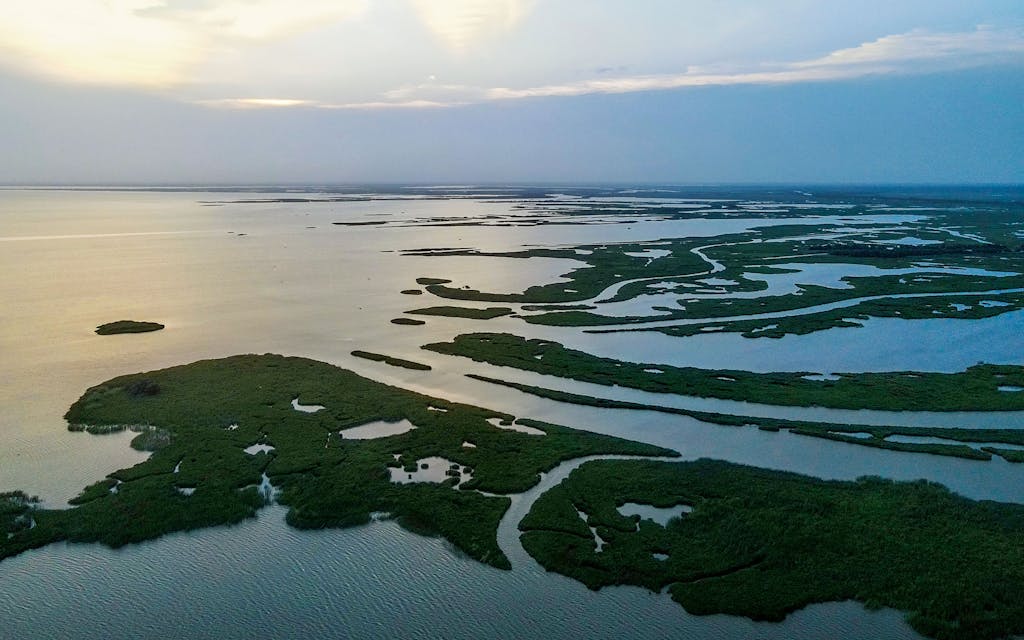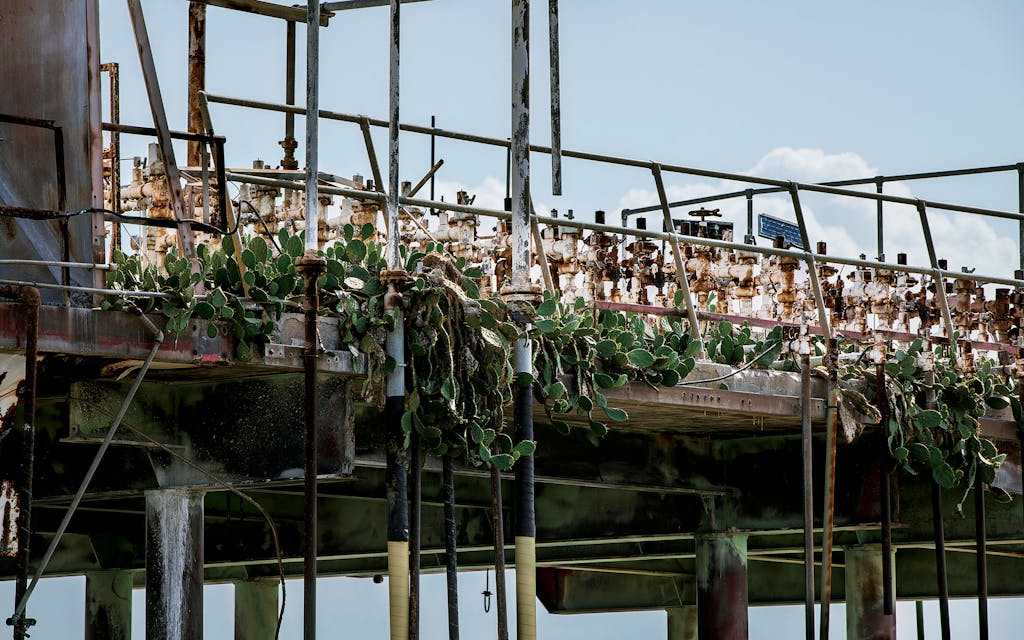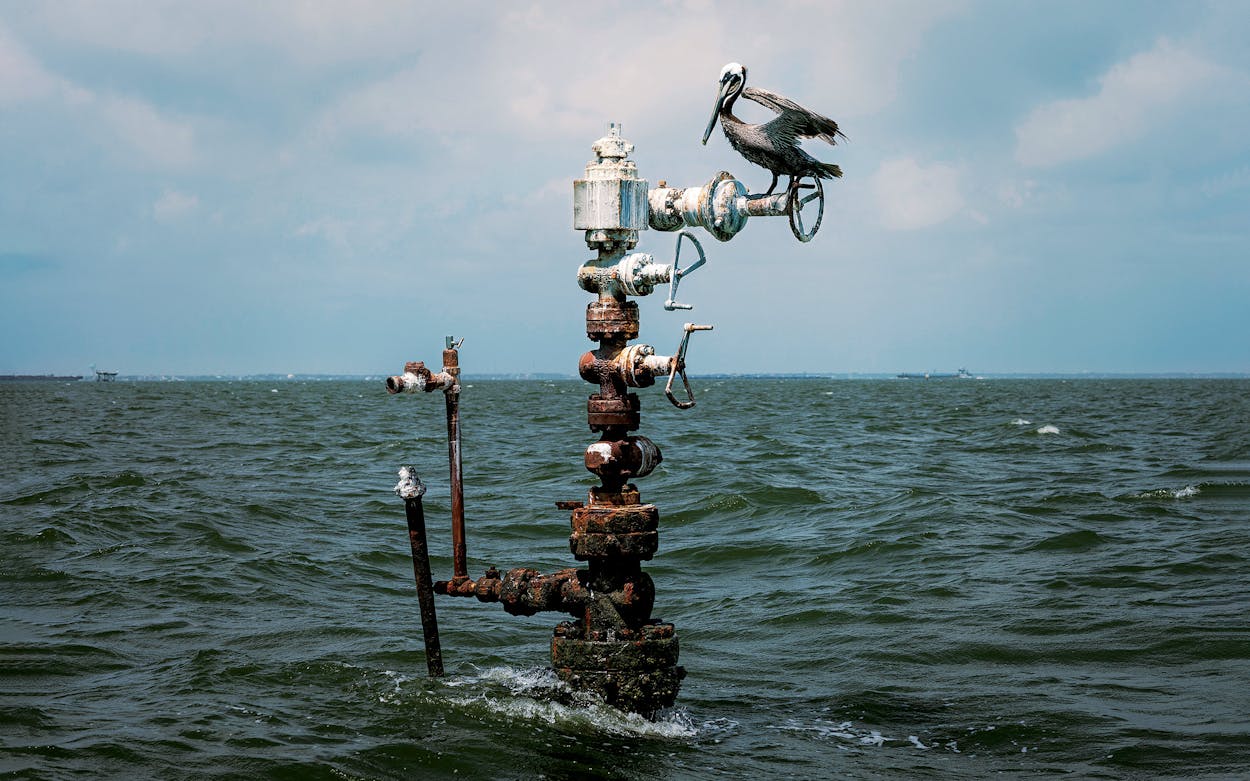Under overcast skies, a four-seat propeller plane took off from an airstrip south of Houston for a routine patrol of the area’s waterways. Its crew, two volunteers with the U.S. Coast Guard Auxiliary, flew low along Buffalo Bayou until they neared downtown. After executing a tight U-turn in their Cessna Skylane, they cut back east, passing north of Baytown, headed for Trinity Bay.
There they spotted a rainbow sheen—about thirty feet wide and a couple of hundred feet long—stretching across the murky water, a telltale sign of a leaking oil well. They had seen and reported it before. Now the well appeared to be releasing petroleum into the bay at a faster rate.
So the Coast Guard again notified the state’s General Land Office, which contacted the Railroad Commission of Texas, a preposterously named institution that has nothing to do with railroads and everything to do with the oil business. A week later, last February, inspectors from both state agencies took a boat out to check on the leak. The metal grating around the well, from which it should have been accessible, had severely corroded, making it too dangerous to stand on. This dashed their hopes for a closer examination, and they settled for snapping a few photographs of the decrepit equipment before heading back to land.

There was no point in trying to get the well’s owner to fix it, because the company no longer existed. The oil spewing into the bay was the state’s problem now. An emergency $100,000 expenditure was approved, and the leak was stopped.
The stakes of such contamination are high. Trinity Bay is where the Trinity River finishes its seven-hundred-mile meander across Texas. The river carries nutrients and fresh water, which mix with the salty water that reaches the bay from the Gulf of Mexico. This fosters a fertile coastal-nursery ecosystem that, among other benefits, feeds seafood-loving Texans. The plants and zooplankton that thrive there provide sustenance for bay anchovy, drum fish, and mullet—parts of a robust food web that also supports populations of crab, flounder, oyster, sea trout, and shrimp.
Despite its proximity to a massive industrial complex along the Houston Ship Channel, the bay remains a relatively healthy environment with a largely undeveloped coastline. “The assumption is that it is destroyed, and that is not true,” says Jim Blackburn, an environmental lawyer who teaches at Rice University. But it’s uncertain how long that can continue. Leaking wells are far from a rare occurrence in its waters.
Trinity Bay is full of oil-and-gas equipment that’s falling apart because of the salty air and turbulent weather. The longer the state waits to clean up this mess, the more leaks will occur and the more expensive it will be to plug the wells and salvage, shutter, and strip what remains of this abandoned oil field. It’s a situation that’s playing out all along the Texas coast, and many who care about protecting such valuable estuaries say the state is doing far too little and moving far too slowly.

Between Baffin Bay, south of Corpus Christi, and Sabine Lake, on the Louisiana border, about 300 wells in state waters sit abandoned by defunct owners. The largest concentration of these is the 119 in Trinity Bay, which is also home to about a dozen decaying platforms.
I first wrote about Texas’s abandoned wells in 1999, and not much has changed since. Every year the state plugs more than a thousand of them, but every year a comparable number are abandoned. There are more than eight thousand wells on the state’s to-plug list. Sisyphus would feel right at home working for the Railroad Commission’s orphan-well program.
On a calm day in June, I set out to see the condition of the Trinity Bay wells with a photographer and Tom Taylor, a semiretired construction-firm owner who agreed to take us out on his 23-foot center-console fishing boat. From a marina on Clear Lake, we inched past the Kemah Boardwalk, its restaurants and rides beckoning, and then out onto the open water. Taylor gunned the engine, and we skimmed two-foot swells as we sped east to the far end of the bay, near the town of Anahuac, where the Coast Guard volunteers had spotted the leak a few months earlier.
Our first stop was a small platform, a dozen feet above the water, on spindly legs. It had once been the collection point for the oil and gas from nearby wells. Two large, rusty white tanks and some wooden pilings stood atop it. About a half dozen wells ringed the platform, at a distance. One of those was barely recognizable as a well, looking more like a dark brown stalagmite rising from the olive-green water. Four posts remained protruding out of the water around it, but gone was the metal grating between the posts that had provided a foothold for oil field crews.
As we drew near this well, Taylor cut the boat’s engine to a low growl. We could hear the loud, persistent hiss of what I assumed was methane, a potent greenhouse gas, leaking into the atmosphere about thirty feet away. Taylor was shocked by how easy it was to hear at that distance, “even with the engine running and water splashing.” We soon moved on, deciding it wasn’t safe to operate a powerful outboard motor so close to flammable gas.
Another platform nearby held a corrugated-metal structure, inside of which were two large compressors that once pumped gas into pipelines. We spied the abandoned machinery through the building’s broken windows. One strong hurricane seemed likely to put the entirety of the structure at the bottom of the bay.
Other platforms were overgrown with cacti or held empty and partially filled fifty-gallon plastic chemical-storage tanks. Nearby, pipelines jutted out of the water, looking like serrated hooks. This was no longer an oil field. It was a junkyard. The only visitors to these wells anymore were brown pelicans.
Humble Oil, now part of Exxon, drilled the Trinity Bay wells in the sixties and seventies and operated them for a couple of decades before several changes of ownership finally left them in the hands of the now defunct Galveston Bay Operating Company. Once based in the Houston suburb of Spring, the firm slid into bankruptcy in 2019, and its operator license expired in 2020.
If the wells were a few miles to the south, in federal waters, the U.S. government would have legal tools to go after any of the still-operating previous owners to fund repairs and the removal of equipment. In that hypothetical case, Exxon—which recently reported $7.9 billion in quarterly earnings—could be forced to pay such costs.
But Texas, like other Gulf Coast states, has chosen a different path. Once an oil well is sold in the state, a former owner gets to wash its hands of all future liability. Oil-and-gas operators are required to pay fees into the state’s orphan-well-plugging fund, but the fund is too small to address the scope of the problem. So taxpayers are likely on the hook for future cleanup costs.
“This is a self-inflicted wound,” says Mark Agerton, an assistant professor of resource economics at the University of California, Davis, and recently the lead author on a study estimating it would cost $177 million to plug all the inactive wells in Texas state waters. “Companies are responding to the rules and incentives.” Agerton’s projected cost would not cover the expense of removing pipelines and platforms.
Companies commonly take advantage of these rules by selling oil fields that are nearing the end of their productive life in order to pass on the environmental liability, like a game of hot potato. For Trinity Bay, the music stopped a couple of years ago, when Galveston Bay Operating apparently went under. This came after a convoluted few years in which the Trinity Bay wells were involved in multiple bankruptcy proceedings and an unsuccessful attempt to transfer the wells to a company run by a man from the Woodlands who was under federal indictment for wire fraud related to an oil investment.
In 2021, Railroad Commission inspectors found wastewater flowing into Trinity Bay out of a rusty pipe. They soon determined that GBO, still in the midst of a bankruptcy, had handed off operations to a company that wasn’t registered with the state. By July of that year, the Trinity Bay wells were no longer producing oil, and GBO was more than a year delinquent in filing required paperwork. Its wells were orphans. After that, every so often another Coast Guard flight would spot a leak and report it.
Plugging just a few offshore wells could eat up a significant portion of the Railroad Commission’s budget for orphans. While so far in 2023 the agency has spent an average of $30,000 closing up a single well—factoring in both those on land and in the water—the commission outlaid $430,000 earlier this year dealing with a single leaking Trinity Bay well. And that only covered stopping the flow and removing oil from the bay. The well still isn’t plugged.
The agency also spent more than $1.3 million to plug a leaking well off Bolivar Peninsula, according to state records obtained by the watchdog investigative group Documented. And last year it cost the state almost $1.7 million to stop a leaking well off Padre Island National Seashore. Regulators had known for fifteen years that the well was in bad shape but didn’t do anything about it. After the leak was discovered, by a fisherman, it took months to stop because the well’s degraded platform made it difficult for workers to reach.
Cruising around Trinity Bay, I couldn’t help but wonder what message it sends to have wells frequently leaking into one of the nation’s most fecund estuaries, near one of its largest cities. Shouldn’t “Don’t Mess With Texas” be more than an advertising slogan?
Back in 2012 Rick Stewart, then an oil attorney in Houston, led an effort to encourage the General Land Office to do something about abandoned oil platforms. In the byzantine world of Texas regulation, the Railroad Commission is responsible for orphan wells, but the GLO oversees platforms.
Stewart and his collaborators sent the agency photographs of a few platforms on the western side of Galveston Bay and gave each of them nicknames. Smelly Bird, for instance, had been painted white by pelican excrement. “It wasn’t right. It wasn’t legal. Something needed to be done,” Stewart recalls thinking. He and the others persuaded the GLO to remove seven platforms and expressed hopes that the work would continue farther east, in Trinity Bay.
But that never happened. I contacted the agency to ask why and eventually received a call back in July from Dawn Buckingham, who was elected state land commissioner last November. She told me that she had been working for months on a plan to deal with the abandoned platforms in Trinity Bay. The GLO couldn’t remove the platforms until the Railroad Commission plugged the wells. So, she explained, the GLO offered $10 million to the Railroad Commission to plug wells. “It took a little persuading for some weird reason,” she said. “We’ve had multiple conversations with the staff over at the Railroad Commission, and at first they didn’t seem very interested.” (A Railroad Commission spokeswoman disputed the agency’s purported lack of interest.)
When I asked Buckingham whether her decision to target Trinity Bay wells had anything to do with Texas Monthly’s inquiry about the platforms, she responded in a sugary tone. “Well, sweetheart, I would love to tell you you’re the center of the world,” she said. “It predated you.” It also predated her time as commissioner. The GLO later provided emails indicating its staff had begun working on this offer to the Railroad Commission in the summer of 2022. But the agency didn’t send over paperwork to transfer the $10 million until July of this year, a few weeks after I started asking about the wells. Regardless of what set this in motion—and whether or not I am the center of the world—attention was being paid to the bay’s oil field.
A couple of days after our Trinity Bay voyage, the photographer who accompanied me reported to federal authorities the location where natural gas seemed to be escaping from a well. The Coast Guard passed the information to the state. Days later, Railroad Commission and GLO inspectors confirmed the leak. It took more than a month to stop it.
This article originally appeared in the October 2023 issue of Texas Monthly with the headline “Oil’s Abandonment Issues.” Subscribe today.
- More About:
- Politics & Policy
- Energy
- Business









